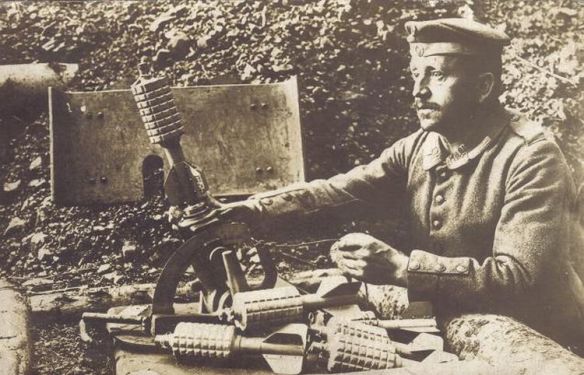Here is a photo of a Priester. The firer is a bit close to it. Normally it was fired by tugging a cord about one metre long. The strange name Priester is allegedly due to the fact that the weapon was invented by a Hungarian priest named Vecer. Originally deployed with the Austro-Hungarian army, it was made under license by (amongst others) Stocks of Berlin for the German army, where it was also called the Granatwerfer 16. The bomb weighed 2 kg and had a maximum range of 500 metres. The weapon was manned, like all other such types, by the engineers
World War I was notable for the incredible advances in technology that changed the way wars were fought. But a weapon that had not been used for nearly 250 years became one of the most important weapons for trench warfare. Mortars—short-range artillery weapons designed to lob bombs—had been introduced in 1673 to blow up forts but had rarely been used since the eighteenth century.
At the beginning of the war, the Germans massed about 150 mortars to defend their forts near Metz. But when fighting along the Western Front bogged down into trench warfare later in 1914, the mortars were moved to the front-line trenches to throw bombs into the French trenches a few hundred feet away. The mortars could destroy the barbed wire barricades protecting the Allied trenches from troop advances. The Germans, with their mortars of various sizes, “were masters with the trench mortar from beginning to end,” according to Dooly[1].
The Allies did not have similar mortars to use in counterattack, so they searched museums for suitable mortars from past wars and used them as models. Until the French introduced their first 58mm trench mortar in 1915, Allied soldiers on the front lobbed makeshift bombs made of nails and explosive powder. The Allies did not develop mortars as mobile as the Minenwerfer (German mortars) until near the end of the war, when the French introduced their 150mm mortar in 1918.
At the start of the war, the Germans had two kinds of Minenwerfer – the heavy Minenwerfer (250mm calibre, 97 kilo shell) and the medium Minenwerfer (170mm calibre, 54 kilo shell.) Both weapons had been designed for use in offensive fortress warfare and, in particular, for clearing barbed wire entanglements and other obstacles. Because of these, all of the shells provided were of the high explosive type.
Early in the war, the Germans introduced the light Minenwerfer (76mm calibre, 4.6 kilo shell). Also designed to deal with obstacles, this piece was also provided with high explosive shells. The light Minenwerfer was adapted to fire directly at tanks.
Later in the war, the Germans added a fourth type of Minenwerfer to the inventory, the 240mm Flügelminenwerfer, which fired a shell that was similar to that of the heavy Minenwerfer, but had an advantage in the realm of range.
While some smoke, illumination, gas and carrier (for sending messages) shells were provided for the Minenwerfer, high explosive remained the projectile of choice throughout the war.
I’ve not heard of any attempts to make a shrapnel shell for the Minenwerfer. Indeed, it is hard to imagine an artillery piece that was less well suited to firing the sort of shrapnel shell used during World War I than the Minenwerfer.
The Priesterwerfer was called the ‘kleine Granatenwerfer 1916’ by the Germans. It was a small spigot mortar that had come from the Austrian army (who called it the Priesterwerfer) and had been designed by a Hungarian priest (Vecer). It fired a 2kg shell with a range of 200-500m and weighed only 40kg. The shell was effective as it hardly penetrated the ground before exploding so most of the shell fragments went horizontally.
[1] William G. Dooly Jr.’s Great Weapons of World War I,
